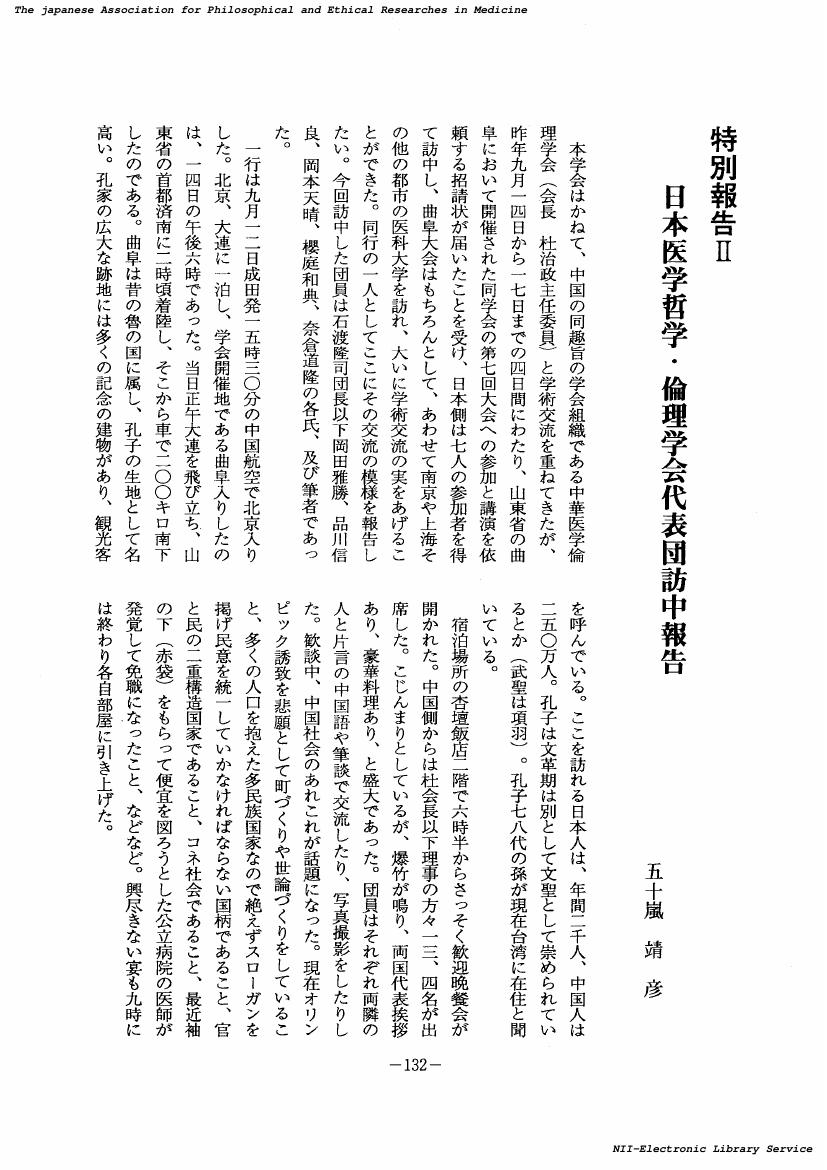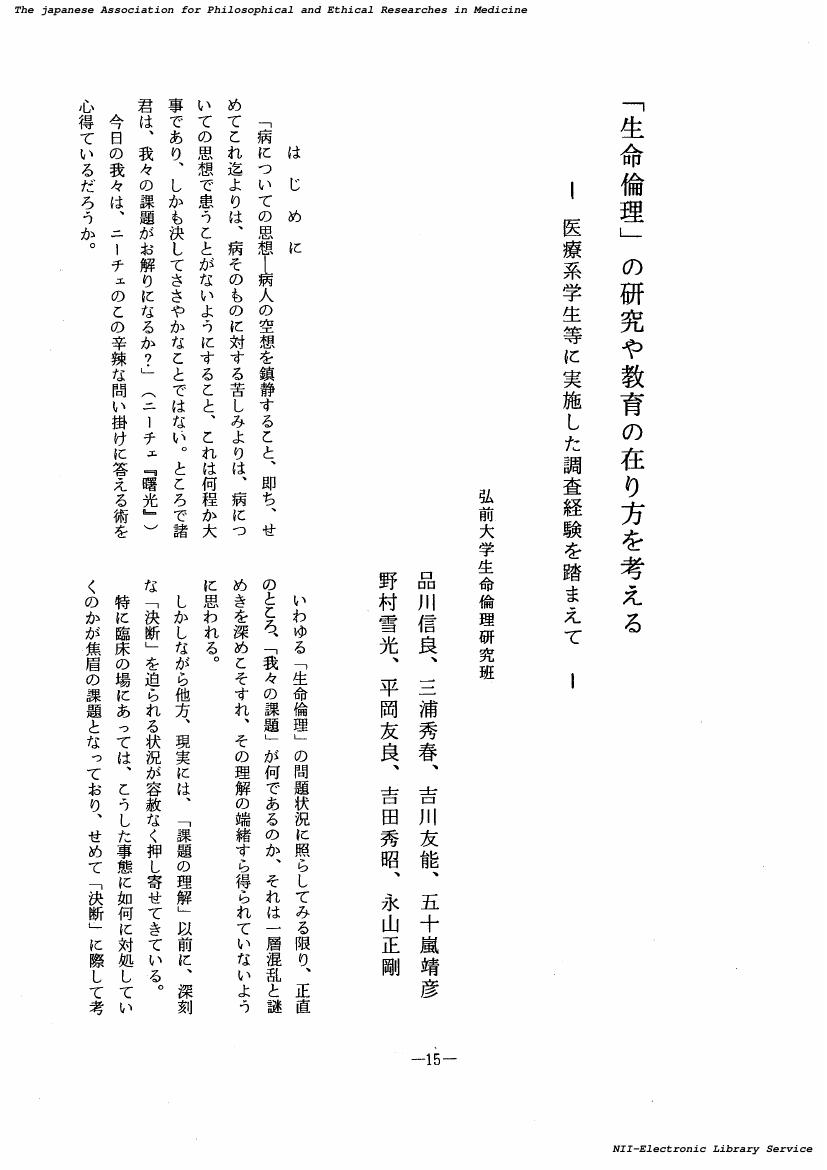- 著者
- 工藤 せい子 五十嵐 靖彦
- 出版者
- 日本医学哲学・倫理学会
- 雑誌
- 医学哲学 医学倫理 (ISSN:02896427)
- 巻号頁・発行日
- vol.24, pp.75-84, 2006
The purpose of this study was to attempt to determine general ideas for addressing ethical issues in nursing practice. The author interviewed nurses who had experienced cases involving care and related ethical issues. The interview data were analyzed using qualitative research methods. The subjects of analysis were the following three cases: 1. A client who was transferred to the hospital for reoperation but died shortly before operation; 2. A client who was in and out of the hospital for more than 10years because of incurable illness; and 3. A client whose last wish was fulfilled in the form of a Christmas party. Analysis showed that ideas for addressing ethical issues converged into two categories. The first included ethical issues, including "role as the client's advocate," "coordination between the client's wishes and the doctor's policy," and "paternalism and maternalism". The other category included issues related to caring, including "learning from the client," "formation of a strong bond resulting from mutual relationship," "involvement as a team," and "departure from medical rules". There were, in addition, three keys to addressing ethical issues that did not fit into either category: "hope for peaceful settlement of affairs," "hope for successful communication," and "wish to be treated indulgently". These three keys are useful both in care for patients and addressing ethical issues.
1 0 0 0 OA 医療における自律原理
- 著者
- 五十嵐 靖彦
- 出版者
- 東北哲学会
- 雑誌
- 東北哲学会年報 (ISSN:09139354)
- 巻号頁・発行日
- vol.10, pp.81-83, 1994-06-30 (Released:2018-02-28)
1 0 0 0 OA 看護実践における倫理的問題解決のための概念を見出す試み : 事例分析から
- 著者
- 工藤 せい子 五十嵐 靖彦
- 出版者
- 日本医学哲学・倫理学会
- 雑誌
- 医学哲学 医学倫理 (ISSN:02896427)
- 巻号頁・発行日
- vol.24, pp.75-84, 2006-10-24 (Released:2018-02-01)
The purpose of this study was to attempt to determine general ideas for addressing ethical issues in nursing practice. The author interviewed nurses who had experienced cases involving care and related ethical issues. The interview data were analyzed using qualitative research methods. The subjects of analysis were the following three cases: 1. A client who was transferred to the hospital for reoperation but died shortly before operation; 2. A client who was in and out of the hospital for more than 10years because of incurable illness; and 3. A client whose last wish was fulfilled in the form of a Christmas party. Analysis showed that ideas for addressing ethical issues converged into two categories. The first included ethical issues, including "role as the client's advocate," "coordination between the client's wishes and the doctor's policy," and "paternalism and maternalism". The other category included issues related to caring, including "learning from the client," "formation of a strong bond resulting from mutual relationship," "involvement as a team," and "departure from medical rules". There were, in addition, three keys to addressing ethical issues that did not fit into either category: "hope for peaceful settlement of affairs," "hope for successful communication," and "wish to be treated indulgently". These three keys are useful both in care for patients and addressing ethical issues.
1 0 0 0 OA 死や臨死をめぐるオランダの実情
- 著者
- テン・ハーフ ヘンク・A・M・J 五十嵐 靖彦
- 出版者
- 日本医学哲学・倫理学会
- 雑誌
- 医学哲学 医学倫理 (ISSN:02896427)
- 巻号頁・発行日
- vol.22, pp.127-136, 2004-10-18 (Released:2018-02-01)
In the last three decades, euthanasia has been a topic of continuous debate in the Netherlands and elsewhere. I is obvious that euthanasia has medical, moral and legal aspects, but it also has cultural, social and political dimensions. In the Netherlands, after three decades of debate and practical experience, euthanasia is since April 2002 regulated as a legitimized medical intervention under particular conditions. However, the legal regulation of euthanasia does not mean that the practice has lost its controversial and contentious character. In this presentation I will focus on four issues. First, the legalization of euthanasia in the Netherlands, identifying the characteristics of the new law. Second, rules and regulations in European countries will be compared, especially the laws in Belgium and the Netherlands. It is also clear that the medical practice of euthanasia varies significantly among European countries, contrary to the implicit assumption that physicians in the Netherlands practiced openly what was hidden in other countries. Third, the issue of legalization, and the various moral and pragmatic arguments pro and con legalizing euthanasia, will be analyzed. Finally, different approaches to death and dying seem to emerge from the euthanasia debate. Three approaches are distinguished: controlled death, preventive death, and palliated death. The increasing focus on the patients' quality of life is an opportunity for the emerging approach of 'palliated death', going beyond the images of 'controlled death' and 'preventive death'.
1 0 0 0 OA 海外研修報告
- 著者
- 五十嵐 靖彦
- 出版者
- 日本医学哲学・倫理学会
- 雑誌
- 医学哲学 医学倫理 (ISSN:02896427)
- 巻号頁・発行日
- vol.15, pp.167-169, 1997-09-20 (Released:2018-02-01)
1 0 0 0 OA 第九回ヨーロッパ医学医療哲学学会大会に参加して(海外報告)
- 著者
- 五十嵐 靖彦
- 出版者
- 日本医学哲学・倫理学会
- 雑誌
- 医学哲学 医学倫理 (ISSN:02896427)
- 巻号頁・発行日
- vol.14, pp.177-179, 1996-10-01 (Released:2018-02-01)
1 0 0 0 OA インフォームド・コンセントとは何か(指定討論)(パネルディスカッション インフォームド・コンセントとは何か,<特集>病とは何か・癒しとは何か インフォームド・コンセントとは何か)
- 著者
- 五十嵐 靖彦
- 出版者
- 日本医学哲学・倫理学会
- 雑誌
- 医学哲学 医学倫理 (ISSN:02896427)
- 巻号頁・発行日
- vol.13, pp.182-187, 1995-10-01 (Released:2018-02-01)
Recently in the field of health care in Japan, as in other countries, there is increasing number of people below that every person has a right to self-decision concerning health can, so that no medical intervention may be carried out without voluntary and informed consent. This argument is, of course, valid and persuasive, at last theoretical. However once we apply this principle to each and every case of health care, we immediately confront some difficulties. Because medical case has infinite variable, and in many cases we cannot forefully obtain free and informed consent. In the first half of this paper, we consider the theoretical and historical validity of the informed consent principle. In the second half, circumstances which make it difficult to take care of patients in accordance with the concept of informed consent will be pointed out.
1 0 0 0 OA 日本医学哲学・倫理学会代表団訪中報告
- 著者
- 五十嵐 靖彦
- 出版者
- 日本医学哲学・倫理学会
- 雑誌
- 医学哲学 医学倫理 (ISSN:02896427)
- 巻号頁・発行日
- vol.12, pp.132-136, 1994-10-01 (Released:2018-02-01)




